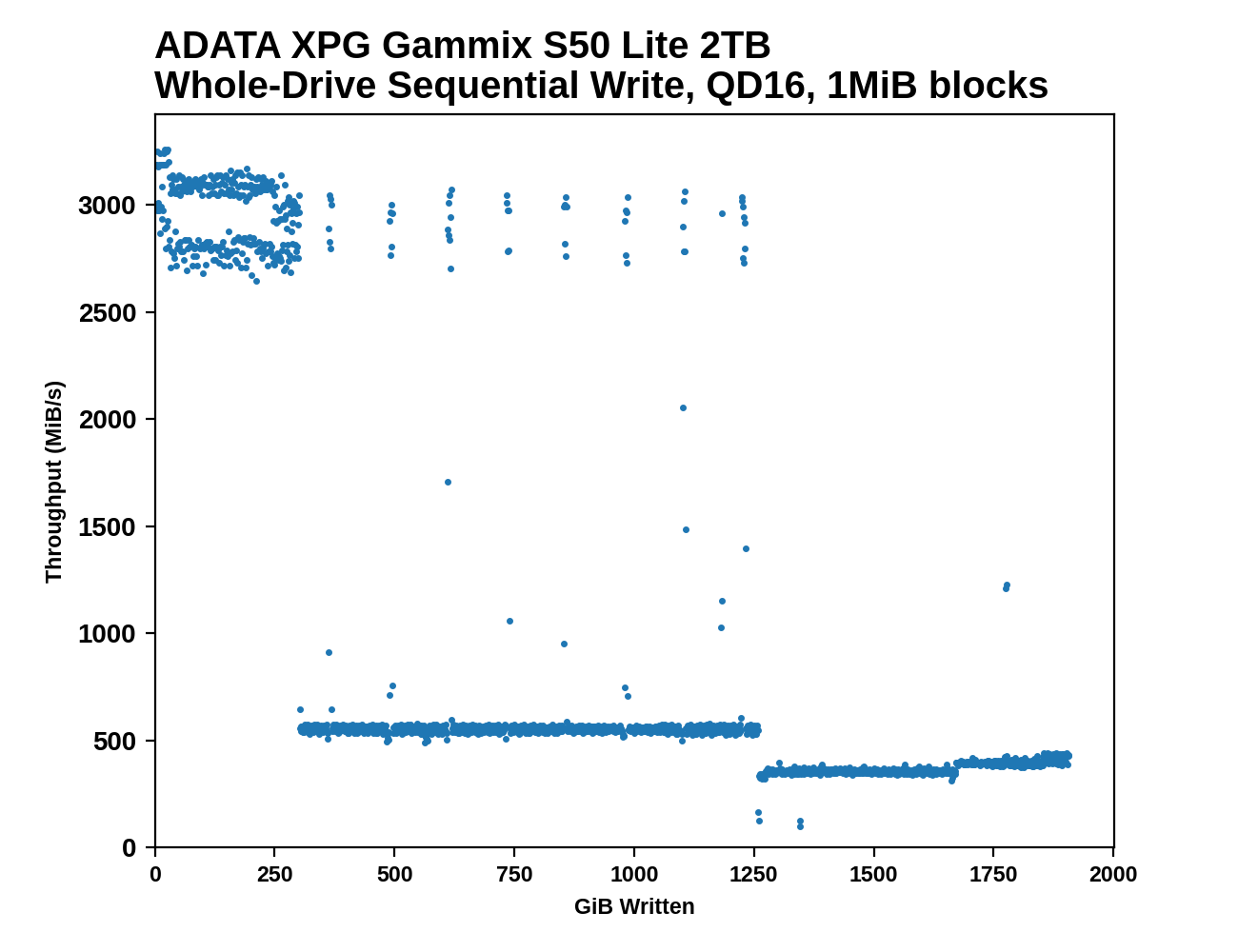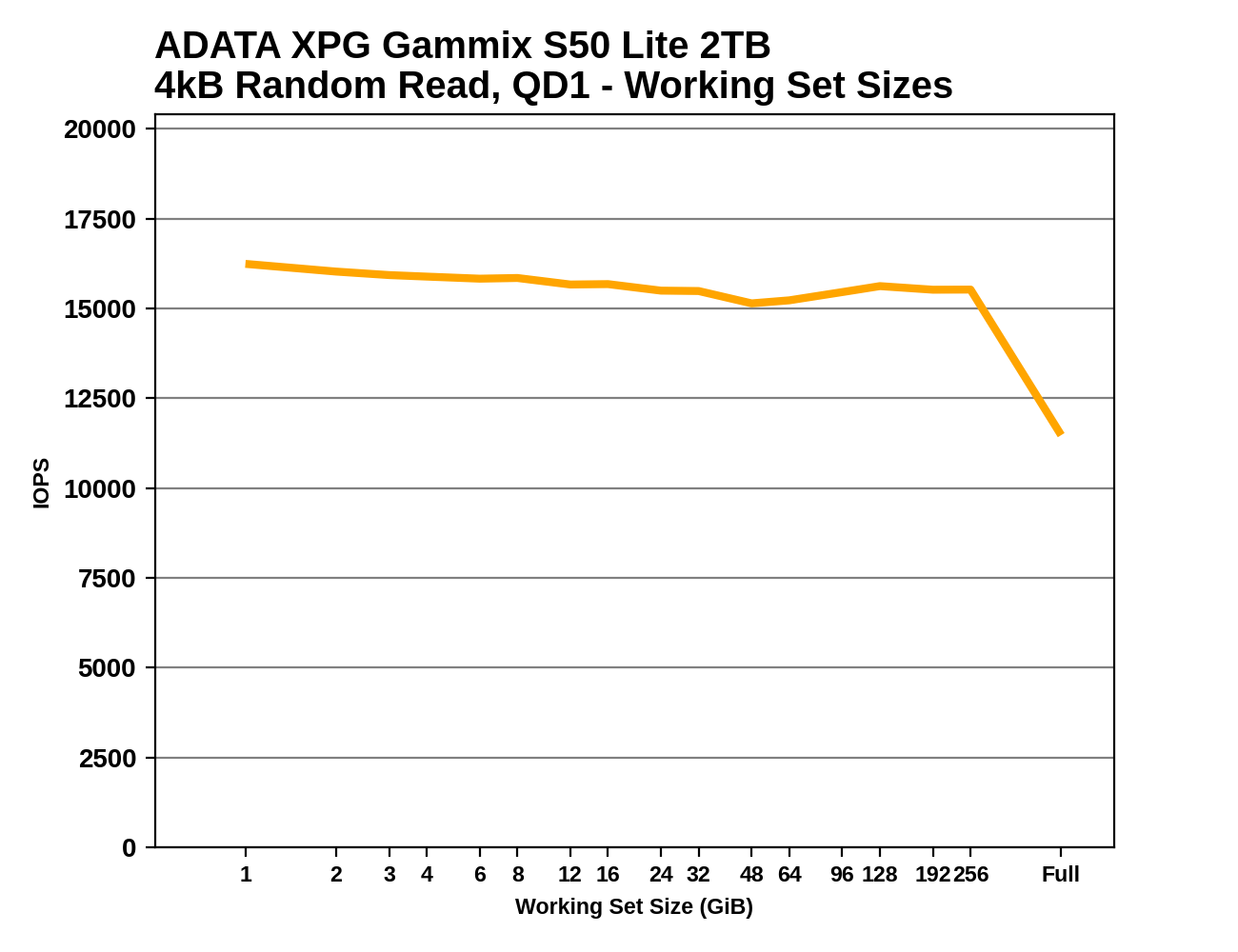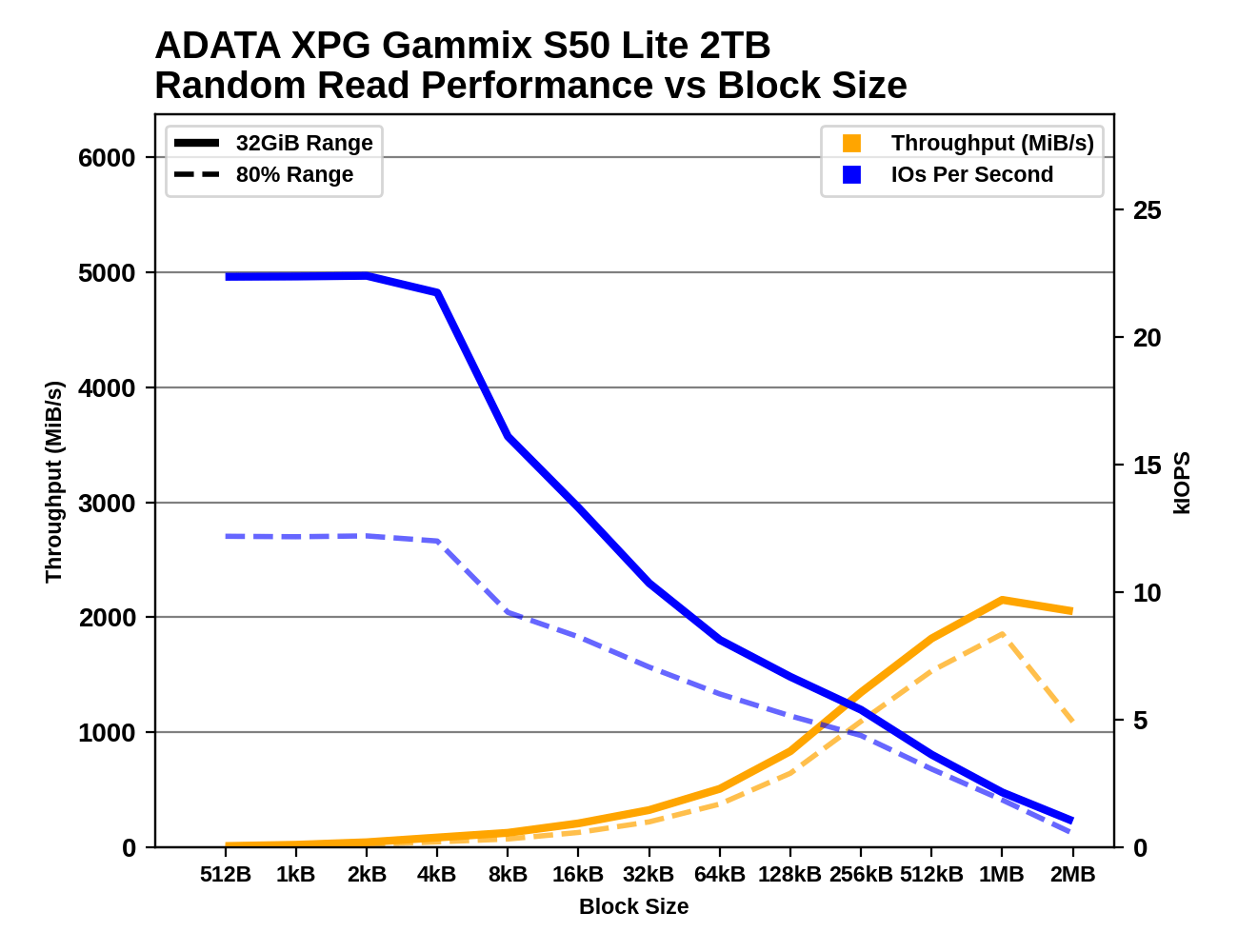The ADATA GAMMIX S50 Lite 2TB SSD Review: Mainstream PCIe Gen4
by Billy Tallis on April 30, 2021 8:00 AM ESTAdvanced Synthetic Tests
Our benchmark suite includes a variety of tests that are less about replicating any real-world IO patterns, and more about exposing the inner workings of a drive with narrowly-focused tests. Many of these tests will show exaggerated differences between drives, and for the most part that should not be taken as a sign that one drive will be drastically faster for real-world usage. These tests are about satisfying curiosity, and are not good measures of overall drive performance. For more details, please see the overview of our 2021 Consumer SSD Benchmark Suite.
Whole-Drive Fill
 |
|||||||||
| Pass 1 | |||||||||
| Pass 2 | |||||||||
The ADATA XPG Gammix S50 Lite shows an almost QLC-like performance drop when the SLC cache runs out after about 300GB: it falls down to SATA speeds. But even though its post-cache write speed is half of what we're used to seeing from TLC drives (most of which use controllers with 8 channels rather than 4), the S50 Lite still has a big lead over the two QLC drives in this bunch.
On the second pass of filling the drive, the S50 Lite's SLC cache is good for only about 14GB and the post-cache performance is much less consistent, with frequent drops below 100MB/s and spikes back up to SLC speeds around 3GB/s.
 |
|||||||||
| Average Throughput for last 16 GB | Overall Average Throughput | ||||||||
Working Set Size
 |
|||||||||
The S50 Lite has excellent random read latency for smaller working sets, beating all but two of the drives in this bunch. But the consequences of having only 1GB of DRAM for a 2TB drive show up at the end of the test, where the random read performance falls off sharply once the reads span the entire drive rather than just a small slice.
Performance vs Block Size
 |
|||||||||
| Random Read | |||||||||
| Random Write | |||||||||
| Sequential Read | |||||||||
| Sequential Write | |||||||||
The S50 Lite offers the same random read IOPS for all the IO block sizes from 512 bytes up to 4kB, but when testing random writes there's a clear preference for 4kB block sizes rather than anything smaller. Rather surprisingly, sequential reads with 4kB block sizes are far slower than for slightly smaller or larger block sizes; it would appear that the drive assumes 4kB reads will be random IO, and skips whatever caching or prefetching is active when using other block sizes.










93 Comments
View All Comments
utmode - Sunday, May 2, 2021 - link
@Billy Tallis, is there any recent research done on data retention on QLC drive. Electrons are very naughty at staying at a set voltage.Billy Tallis - Sunday, May 2, 2021 - link
Write endurance limits are set based on how much you can wear out the flash and still have one year of unpowered data retention (or three months for enterprise drives). That's still largely determined with high-temperature accelerated testing, but it's pretty well understood how to do that properly.bansheexyz - Saturday, May 1, 2021 - link
Can we ban this idiot already? A 10TB QLC drive will have a larger write endurance than a 2TB TLC drive does today. There is nothing inherently wrong with QLC tech, its supposedly inferior write endurance is self-mitigating by the fact that there are more cells to spread writes across. Which is exactly why TLC overtook MLC, and MLC overtook SLC. Go the frick away.GeoffreyA - Sunday, May 2, 2021 - link
Not a fan of freedom of speech/expression/press? Especially when it comes to these money-driven corporations, one needs to put whatever they do under a microscope and pay little heed to their words.There's nothing wrong with QLC. It's a product with a place: supposedly, bigger size and cheaper price. (Concerning endurance, if the ratings are true and not made up, they ought to be fine for most people.) But as far as I can see, QLC isn't *that* much cheaper than TLC. About 15-20% or something to that effect. Costly to make, greed, the pandemic, or all three?
futrtrubl - Sunday, May 2, 2021 - link
That's pretty much what it should be. QLC holds about 33% more than TLC, or, for the same amount of storage QLC uses 25% fewer cells. It's a less mature tech so I wouldn't expect it to get the full 25% savings, and all the other common components will reduce savings too.MFinn3333 - Sunday, May 2, 2021 - link
It is 50% more, not 33%.If you look at the total number states of a TLC which is 8 or 3 bit cells versus a QLC which is 16 states or 4 bit cells.
Billy Tallis - Sunday, May 2, 2021 - link
Voltage states are an enumeration of possibilities; they do not occupy physical space and are not the correct quantity to compare when discussing storage capacity.FunBunny2 - Monday, May 3, 2021 - link
"Voltage states are an enumeration of possibilities; they do not occupy physical space"well... would you deny that a larger cell, i.e. one with more atoms, is more capable of storing more distinct voltages with some delta of accuracy? not to mention the whole endurance thingee. IOW, as an applied physics problem, QLC is closer to the razor's edge of performance than lower xLC cells. were all this not true, then manufacturers have been wasting gobs and gobs of moolah to implement stacks of 'olde' larger node NAND for TLC and QLC.
Tamdrik - Sunday, May 2, 2021 - link
But most people don't measure their storage devices by how many different states they can maintain-- they measure them by how many bits (or xxx-bytes) they can store. By that (standard) measure, futrtrubl is correct in that a QLC drive holds 33% more data than a TLC drive with the same number of cells (4 bits per cell vs. 3 bits per cell), and if costs are the same per cell, would be expected to cost 25% less for a given capacity (e.g., 1 TB).Oxford Guy - Sunday, May 9, 2021 - link
'But most people don't measure their storage devices by how many different states they can maintain-- they measure them by how many bits (or xxx-bytes) they can store.'You really think that's a logically-sound rebuttal?